Breakup of China’s Yunhai-1 (02) satellite linked to space debris collisionby Andrew Jones — January 11, 2022
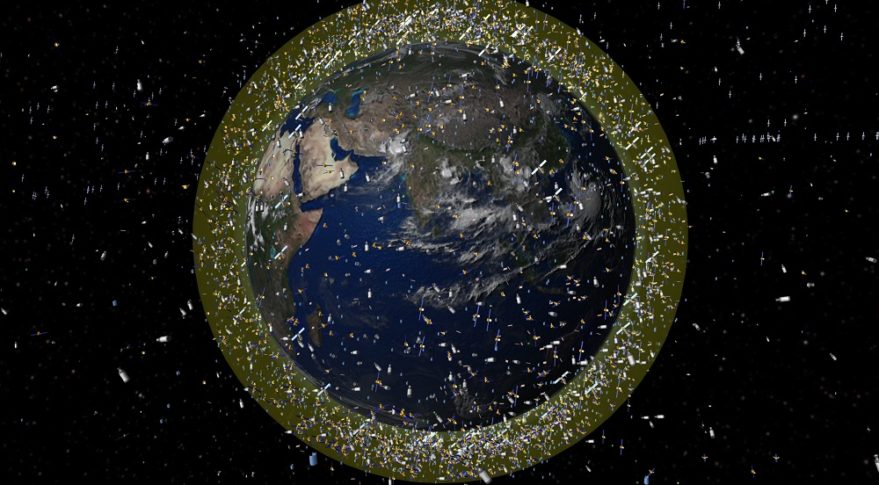 Orbital debris illustration. Credit: ESA
Orbital debris illustration. Credit: ESAHELSINKI — U.S. space tracking has linked the breakup of Chinese satellite Yunhai-1 (02) to a collision with a small piece of debris from a Russian satellite launch, according to NASA.
The Yunhai-1 (02) satellite was developed by the Shanghai Academy of Spaceflight Technology and launched in September 2019 into a Sun-synchronous orbit with an altitude of around 783 kilometers. It suffered a breakup event on March 18, 2021, creating a number of pieces of debris.
The 18th Space Control Squadron (18 SPCS) of the U.S. Space Force has identified the breakup of the Yunhai 1-02 meteorological spacecraft (2019-063A) last year to be an accidental collision with a small, mission-related debris object (1996-051Q) associated with the Zenit-2 launch vehicle for the deployment of the Russian Cosmos 2333 military signals intelligence satellite in 1996, according to the December 2021 edition of Orbital Debris Quarterly News, a publication of NASA’s Orbital Debris Program Office.
Source:
https://spacenews.com/breakup-of-chinas-yunhai-1-02-satellite-linked-to-space-debris-collision/Space debris expert warns U.S. ‘woefully behind’ in efforts to clean up junk in orbitby Sandra Erwin — January 6, 2022 [SN]
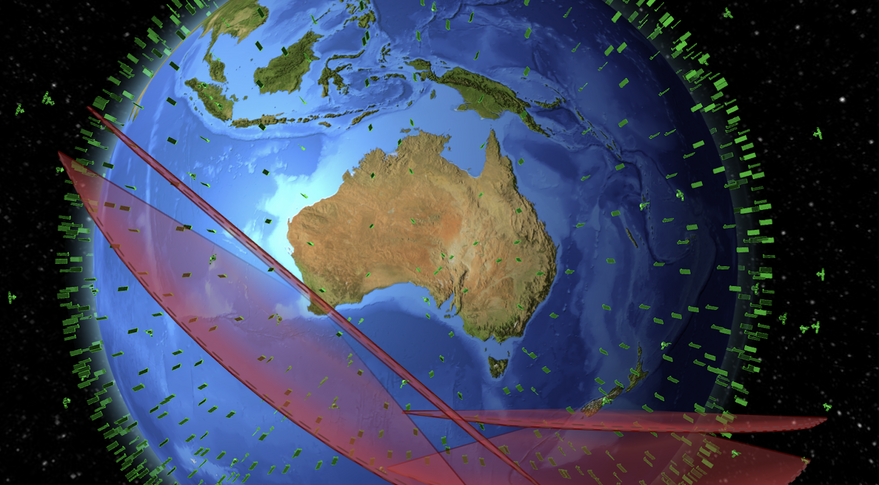 LeoLabs' West Australian space radar conceptual field of view. Credit: LeoLabs
LeoLabs' West Australian space radar conceptual field of view. Credit: LeoLabsDarren McKnight: The problem are not commercial megaconstellations but a failure to deal with existing debris
WASHINGTON — The United States is a space superpower but is not doing as much as other nations to solve the problem of orbital debris, an industry expert said Jan. 6.
Darren McKnight, senior technical fellow at LeoLabs and member of the International Academy of Astronautics’ Space Debris Committee, said initiatives by the U.S. Space Force to fund debris cleanup technologies are laudable but not nearly enough to address what is becoming a serious threat to the space business.
https://spacenews.com/space-debris-expert-warns-u-s-woefully-behind-in-efforts-to-clean-up-junk-in-orbit/U.S. intelligence wants to track currently undetectable orbital space debrisby Sandra Erwin — February 12, 2022 [SN]
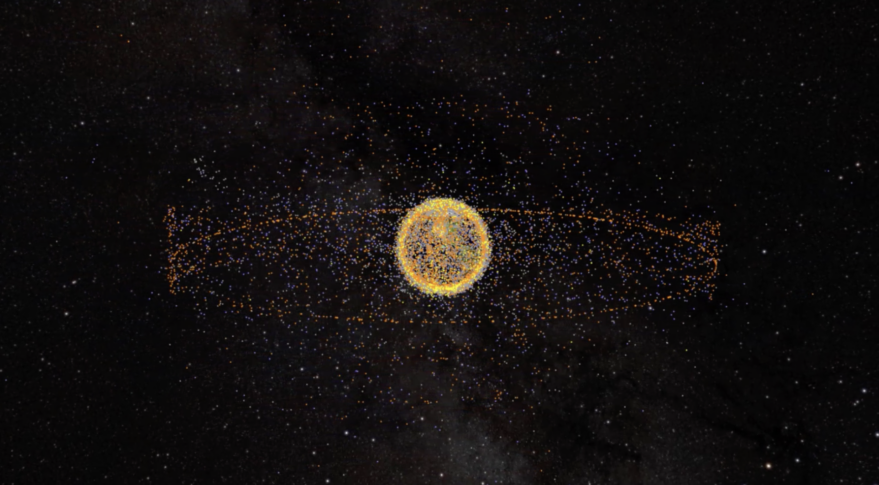 Rendering of Earth orbiting space debris. Credit: NOAAThe Intelligence Advanced Research Projects Activity in a request for information asks for 'innovative approaches to detect and track currently undetectable orbital space debris'
Rendering of Earth orbiting space debris. Credit: NOAAThe Intelligence Advanced Research Projects Activity in a request for information asks for 'innovative approaches to detect and track currently undetectable orbital space debris'WASHINGTON — The U.S. intelligence community — which builds and operates Earth observation and communications satellites for military or intelligence applications — is looking for solutions to the space debris problem.
https://spacenews.com/u-s-intelligence-wants-to-track-currently-undetectable-orbital-space-debris/Chinese rocket, not Falcon 9, linked to upper stage on lunar impact trajectoryby Jeff Foust — February 13, 2022 [SN]
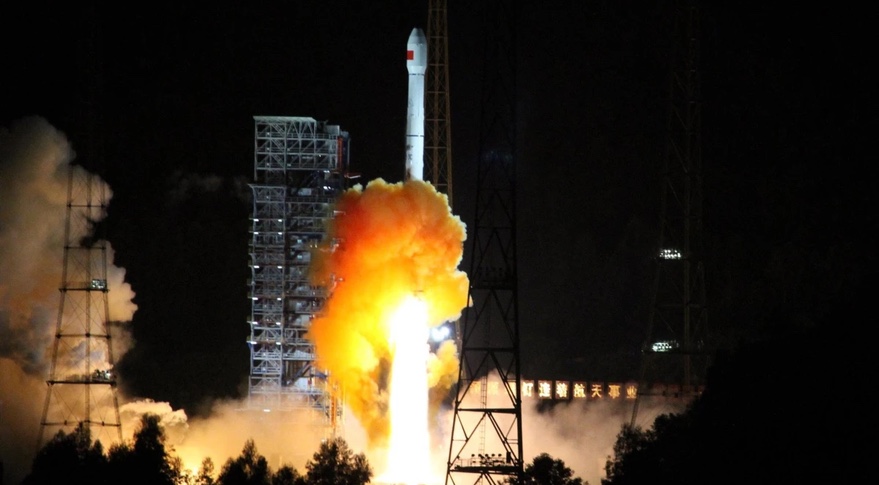 A Long March 3C launches the Chang'e-5 T1 spacecraft in October 2014. The upper stage from the launch is now thought to be the object that will hit the far side of the moon in March. Credit: Xinhua
A Long March 3C launches the Chang'e-5 T1 spacecraft in October 2014. The upper stage from the launch is now thought to be the object that will hit the far side of the moon in March. Credit: XinhuaWASHINGTON — In a case of celestial mistaken identity, a spent upper stage that will crash on the far side of the moon in March is now linked to a Chinese launch in 2014, not a SpaceX launch of an Earth and space science satellite in 2015, illustrating the difficulties in tracking objects beyond Earth orbit.
https://spacenews.com/chinese-rocket-not-falcon-9-linked-to-upper-stage-on-lunar-impact-trajectory/Op-ed | Space Debris Management is even more urgent than Space Traffic Managementby Darren McKnight and Chris Kunstadter — February 15, 2022 [SN]
Space Traffic Management (STM) — the identification and deconfliction of potential mission-terminating collisions for operational spacecraft — has gained attention as the population of operational satellites in low Earth orbit has dramatically increased.
Operational satellites and their supporting infrastructure must be resilient and responsive to mitigate mission-ending or catastrophic collisions to maintain a safe and robust space industry. We applaud the efforts of organizations and policymakers to develop, synchronize, and refine STM principles, including data sharing, state vector accuracy improvement, near-real-time conjunction data messages, and expanding global space surveillance assets.
https://spacenews.com/op-ed-space-debris-management-is-even-more-urgent-than-space-traffic-management/Op-ed | How America Can Become a Leader in Cleaning Up Spaceby Brian Weeden — February 16, 2022 [SN]
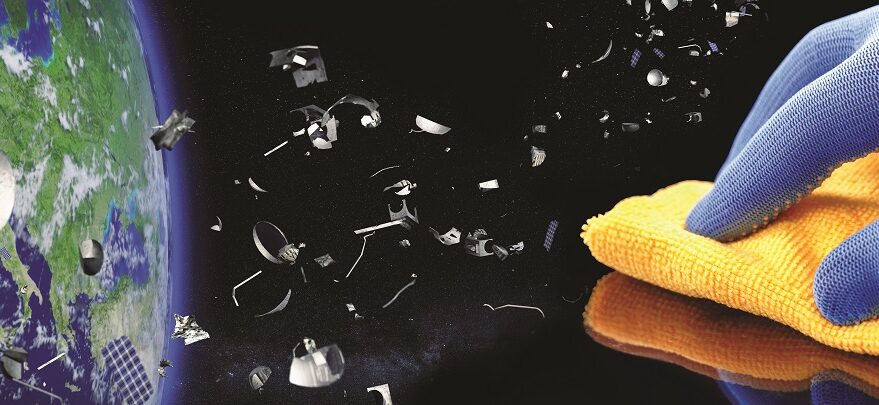 Credit: SpaceNews illustration
Credit: SpaceNews illustrationDuring the first National Space Council meeting of the Biden administration, Vice President Kamala Harris reinforced the importance of outer space for national security, economic development, and environmental security. The future security and sustainability of space hinges on dealing with the over 8,000 metric tons of dead objects already in orbit, including at least 900,000 individual pieces of debris that can be lethal to satellites, which clutter the most heavily-used parts of Earth orbit today. To do this, the United States needs to implement a holistic Space Environment Management (SEM) program, and the most important missing element of that program is the development of remediation capabilities that can remove debris from orbit and help clean up the space environment.
https://spacenews.com/op-ed-how-america-can-become-a-leader-in-cleaning-up-space/Op-ed | The challenges of space traffic managementby Marshall H. Kaplan and Gurpartap Sandhoo — February 18, 2022 [SN]
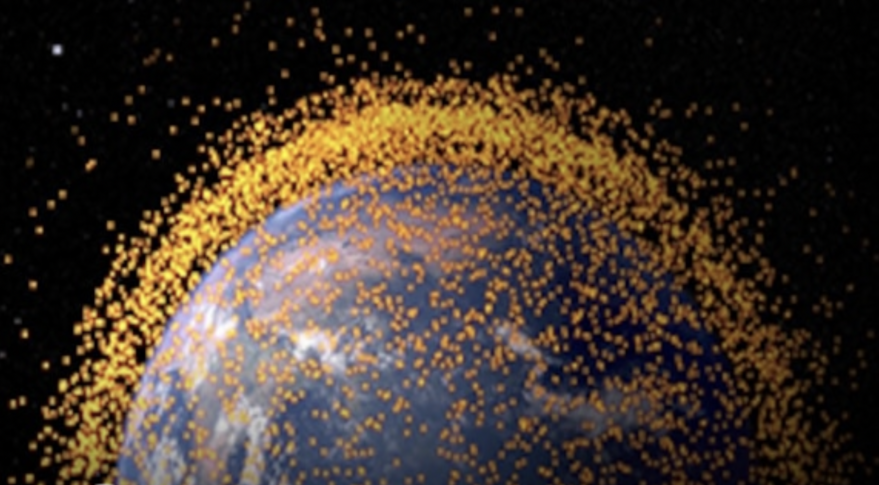 Rendering of Earth's orbit and space debris. Credit: U.S. Space ForceMillions of pieces of orbital debris big enough to harm satellites but too tiny to track threaten "permanent stability and safety in orbit."
Rendering of Earth's orbit and space debris. Credit: U.S. Space ForceMillions of pieces of orbital debris big enough to harm satellites but too tiny to track threaten "permanent stability and safety in orbit."Over the past few years, and especially in the last few months, the issue of space traffic management (STM) has been discussed from the U.S. Senate floor to White House press briefings. The common theme across the government is the lack of action on space traffic management. One of the underlying issues not being addressed is: You cannot manage what you can’t measure. A fundamental tenet of any STM system is detecting, identifying, and accurately tracking all objects within the management domain. Any near-Earth management domain must include all large debris objects. We have yet to develop the needed technologies and systems to anticipate conjunctions among active satellites and large debris objects effectively. In other words, STM today does not exist but is, in fact, the “wild west.” (...)
As of September 2021, the European Space Agency’s Space Debris Office offered a few relevant historical facts:
- The number of successful rocket launches since the space age began in 1957 is roughly 6,100.
- The number of satellites placed into Earth orbit is roughly 12,000, with about 7,500 still in orbit.
- The number of satellites still functioning is about 4,700.
- The number of large debris objects regularly tracked by the U.S. Space Surveillance Network and maintained in their catalog is more than 29,000.
- The number of break-ups, explosions, collisions or anomalous events resulting in fragmentation is over 600.
- The total mass of all space objects in Earth orbits is over 9,600 tons.
- The number of orbiting debris objects greater than 10 centimeters in size, estimated via statistical models, is 36,500. There are 1 million objects between 1 and 10 centimeters in size and 330 million objects between 1 millimeter and 1 centimeter.https://spacenews.com/op-ed-the-challenges-of-space-traffic-management/Slingshot Aerospace closes $25 million fundraising roundby Sandra Erwin — March 10, 2022 [SN]
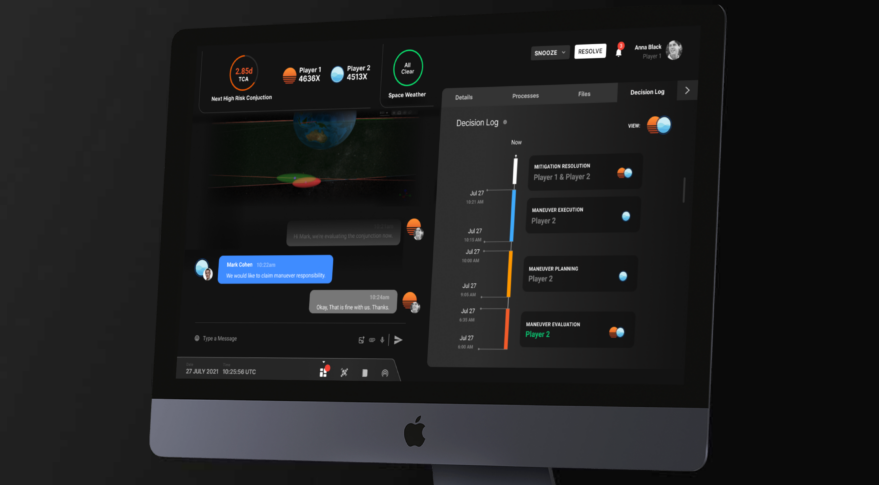 Screenshot of Slingshot Beacon, a collision avoidance data sharing platform. Credit: Slingshot AerospaceThe company plans to use the funds to expand and commercialize its space collision-avoidance platform
Screenshot of Slingshot Beacon, a collision avoidance data sharing platform. Credit: Slingshot AerospaceThe company plans to use the funds to expand and commercialize its space collision-avoidance platformWASHINGTON — Slingshot Aerospace, a company that develops technologies for space situational awareness, announced March 10 it has raised $25 million in Series A-1 funds.
The company has raised $42 million since it was founded in 2017. The new round was oversubscribed, said CEO and co-founder Melanie Stricklan. “We set out to raise $20 million and stopped at $25 million,” she said.
https://spacenews.com/slingshot-aerospace-closes-25-million-fundraising-round/Chinese official calls for protection of space assets, international coordination mechanismsby Andrew Jones — March 10, 2022 [SN]
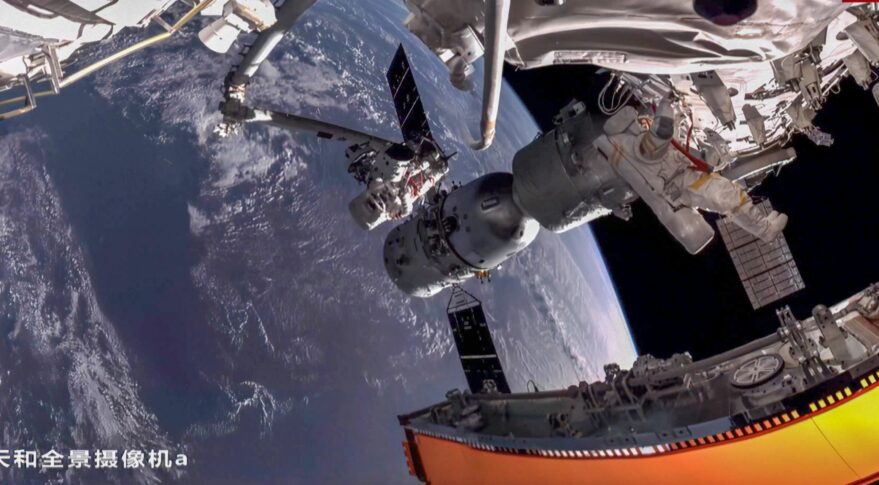 An image from Tianhe panoramic camera A during the first Shenzhou-13 spacewalk in November 2021. Credit: CMSA/CCTV/Chinese Academy of Sciences
An image from Tianhe panoramic camera A during the first Shenzhou-13 spacewalk in November 2021. Credit: CMSA/CCTV/Chinese Academy of SciencesHELSINKI — China needs to accelerate the development of space asset protection policies and related international coordination mechanisms, according to a space industry official.
“We should proactively promote the formulation of space asset protection policies, so that space asset protection activities can be based on the law, and at the same time declare the importance that China attaches to space asset protection,” Yang Mengfei, an academician at the China Academy of Space Technology (CAST), told China National Radio.
https://spacenews.com/chinese-official-calls-for-protection-of-space-assets-international-coordination-mechanisms/Op-ed | Congress must act now to avert a catastrophe in spaceby Dan Dumbacher — March 13, 2022 [SN]
More than 1,500. That’s the additional pieces of debris now floating around in low Earth orbit because of the reckless and irreversible Russian anti-satellite test last November.
Another 13,000 small satellites will be added by the Chinese when they deploy a large constellation to provide internet services.
Then consider the U.S.-licensed companies that have already launched more than 2,000 satellites of a planned tens of thousands of satellites over the next decade.
https://spacenews.com/op-ed-congress-must-act-now-to-avert-a-catastrophe-in-space/Op-ed | The Case for Space Arbitration: Can you recover damages caused by space collisions?by Laura Yvonne Zielinski — March 23, 2022 [SN]
Opening outer space to more and more private parties and multiplying the number of space objects being launched brings about infinite new opportunities — and substantial risks. Therefore, it is likely that the increasing congestion of the lower orbits will soon result in more contractual disputes. We will also see more disputes related to forced avoidance maneuvers and space collisions.
https://spacenews.com/op-ed-the-case-for-space-arbitration-can-you-recover-damages-caused-by-space-collisions/Getting a jump on traffic: The sudden urgency of government-industry partnerships in space traffic managementby Jeff Foust — April 7, 2022 [SN]
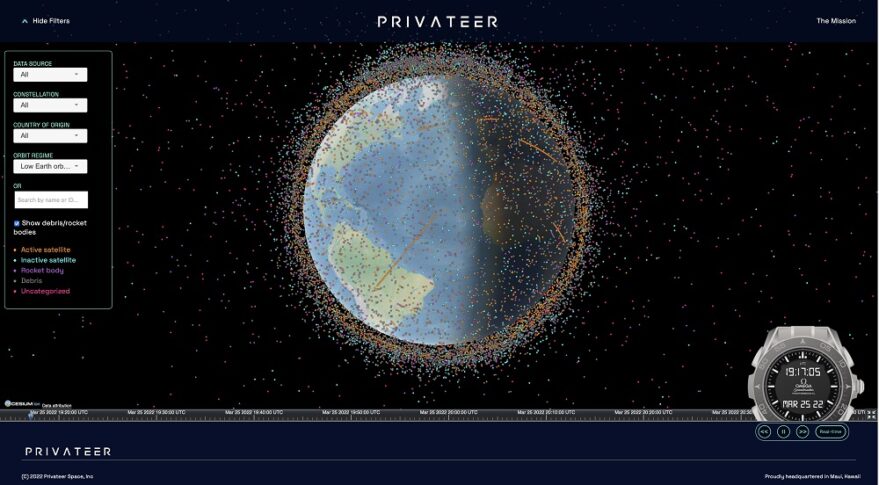 Privateer’s Wayfinder visualization tool combines data from several sources. This scene shows active and inactive low Earth orbit satellites plus rocket bodies and other debris. Credit: Privateer
Privateer’s Wayfinder visualization tool combines data from several sources. This scene shows active and inactive low Earth orbit satellites plus rocket bodies and other debris. Credit: PrivateerSome operators of low Earth orbit satellites are bracing for a storm of debris. Russia’s demonstration of an antisatellite weapon last November, destroying the Cosmos 1408 satellite, created thousands of tracked pieces of debris, and many more too small to be tracked.
https://spacenews.com/getting-a-jump-on-traffic-the-sudden-urgency-of-government-industry-partnerships-in-space-traffic-management/U.S. declares ban on anti-satellite missile tests, calls for other nations to joinby Sandra Erwin — April 18, 2022 [SN]
 Vice President Kamala Harris speaks April 18, 2022, at Vandenberg Space Force Base, California. Credit: @SLDelta30VP Harris: A commitment to not destroy satellites in orbit should become a 'new international norm for responsible behavior in space'
Vice President Kamala Harris speaks April 18, 2022, at Vandenberg Space Force Base, California. Credit: @SLDelta30VP Harris: A commitment to not destroy satellites in orbit should become a 'new international norm for responsible behavior in space'WASHINGTON – Vice President Kamala Harris announced April 18 that the United States will ban direct-ascent anti-satellite (ASAT) missile tests that create orbital debris.
“These tests are dangerous and we will not conduct them,” Harris said in a speech at Vandenberg Space Force Base in California.
https://spacenews.com/u-s-declares-ban-on-anti-satellite-missile-tests-calls-for-other-nations-to-join/India examining crashed space debris suspected to be parts of China’s Long March rocketby Park Si-soo — April 19, 2022 [SN]
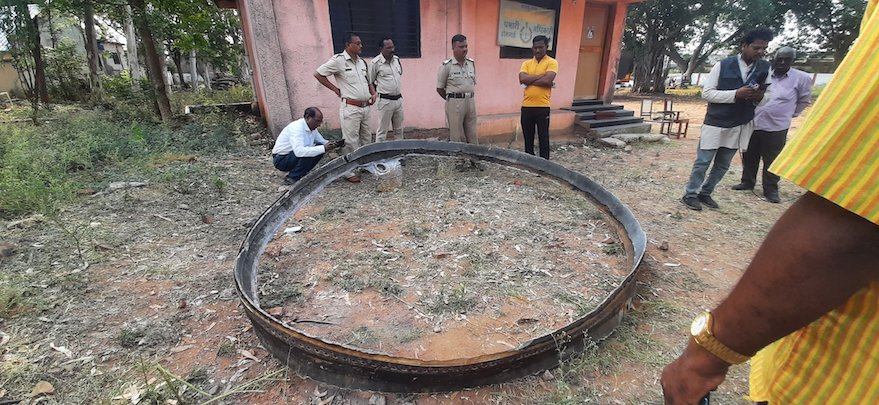 People stand next to a large metal ring that fell into rural western India April 2, along with a cylinder-like object in this photo captured from space-watcher Jonathan McDowell’s Twitter account. They are believed to be parts of a Chinese rocket’s upper stage.If the objects are confirmed to be parts of a Chinese rocket, it would be the second time in less than a year that debris from a Chinese rocket made a troubling re-entry.
People stand next to a large metal ring that fell into rural western India April 2, along with a cylinder-like object in this photo captured from space-watcher Jonathan McDowell’s Twitter account. They are believed to be parts of a Chinese rocket’s upper stage.If the objects are confirmed to be parts of a Chinese rocket, it would be the second time in less than a year that debris from a Chinese rocket made a troubling re-entry.SEOUL, South Korea — India’s space agency is examining a large metal ring and a cylinder-like object that fell into rural western India April 2, with a preliminary investigation suggesting they could be parts of a Chinese space rocket’s upper stage that reentered the atmosphere that day.
https://spacenews.com/india-examining-crashed-space-debris-suspected-to-be-parts-of-chinas-long-march-rocket/DoD a main proponent of anti-satellite test ban: ‘We are not disarming’by Sandra Erwin — April 20, 2022 [SN]
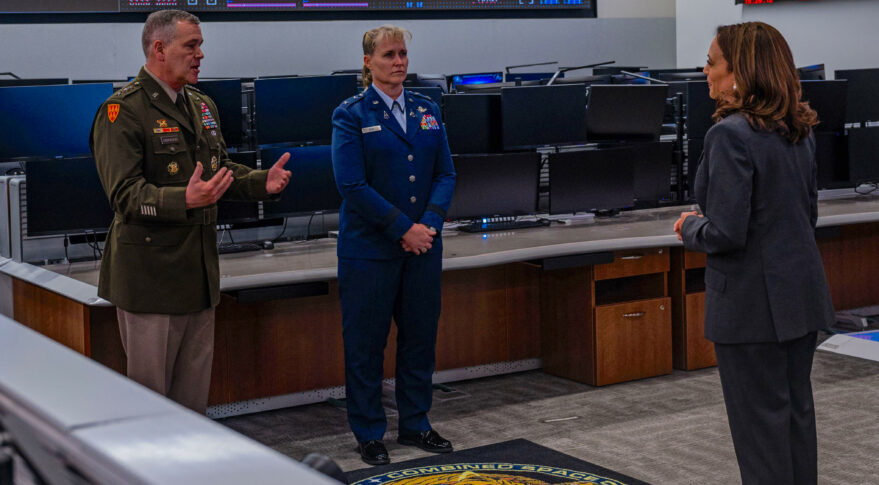 Vice President Kamala Harris meets with Gen. James Dickinson, U.S. Space Command commander and U.S. Space Force Maj. Gen. DeAnna Burt, Combined Force Space Component Command commander, during a visit to Vandenberg Space Force Base, Calif., April 18, 2022. Credit: Tech. Sgt. Luke Kitterman"Space related rules and norms of responsible behavior are in our interest,” said deputy assistant secretary of defense John Hill
Vice President Kamala Harris meets with Gen. James Dickinson, U.S. Space Command commander and U.S. Space Force Maj. Gen. DeAnna Burt, Combined Force Space Component Command commander, during a visit to Vandenberg Space Force Base, Calif., April 18, 2022. Credit: Tech. Sgt. Luke Kitterman"Space related rules and norms of responsible behavior are in our interest,” said deputy assistant secretary of defense John HillWASHINGTON – The Biden administration’s decision to ban anti-satellite missile tests had strong backing from the Defense Department as the military’s own guidelines prohibit debris-creating space activities, a senior official said April 20.
https://spacenews.com/dod-a-main-proponent-of-anti-satellite-test-ban-we-are-not-disarming/Op-ed | Herding rockets: Improved Space Traffic Management will accelerate industry growthby Sita Sonty, Cameron Scott, Troy Thomas and Sarah Zhou — May 11, 2022 [SN]
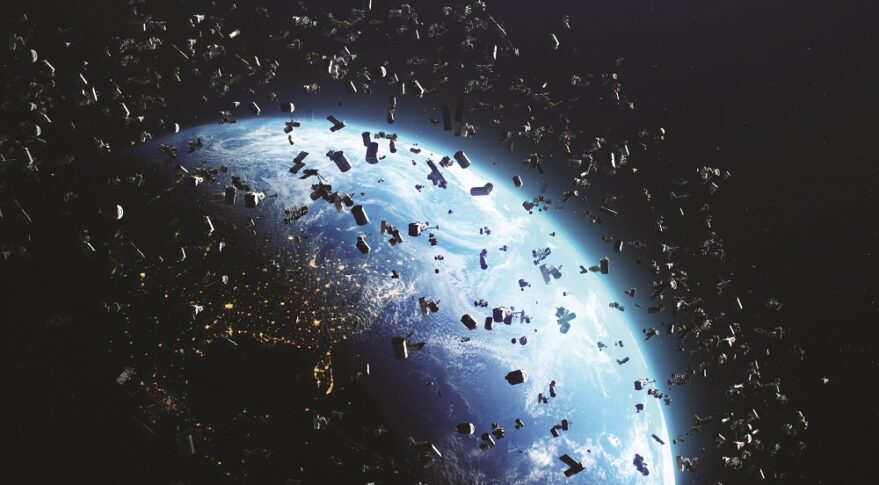 Credit: Adobe Stock
Credit: Adobe StockA market ecosystem that incentivizes the rapid development and fielding of advanced Space Traffic Management (STM) technologies will be a key enabler to the sustainable growth of the space economy. As defined by the International Academy of Astronautics , STM protects future sector growth by encouraging the development and application of technology to preserve access to space and assets already in orbit.
The call for a revamped STM policy structure has been made and includes recommendations for drawing lines around launch, licensing, and funding. Ensuring equal access to space by creating standards for collecting data for Space Situational Awareness (SSA) and space launch will, in turn, increase the likelihood of successful Space Debris Management (SDM), as the more effectively managed the launch market, the lower the volume of space debris to deconflict and mitigate collision risk.
https://spacenews.com/op-ed-herding-rockets-improved-space-traffic-management-will-accelerate-industry-growth/Op-ed | Space Safety Concerns Put Economic Growth at Riskby Dan Dumbacher and Kevin M. O'Connell — May 11, 2022 [SN]
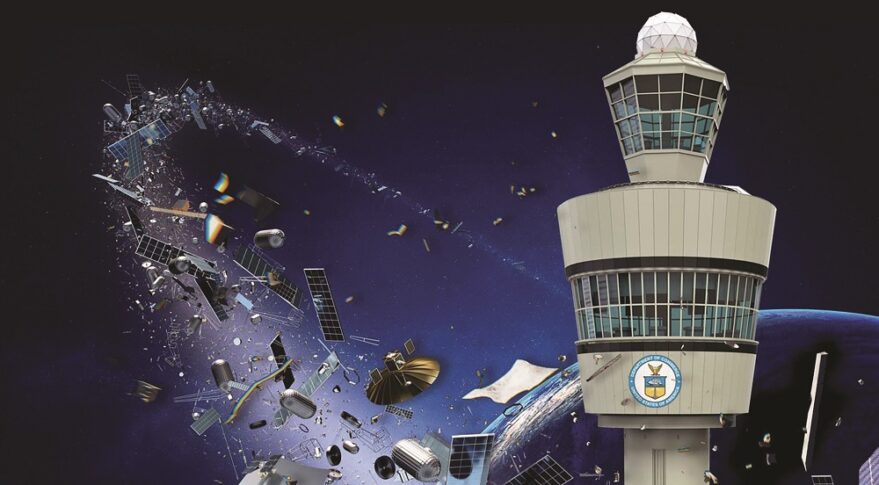 The Office of Space Commerce lacks authorities and resources it needs to take on space traffic management. Credit: SpaceNews illustration
The Office of Space Commerce lacks authorities and resources it needs to take on space traffic management. Credit: SpaceNews illustrationVice President Kamala Harris’ recent announcement of a U.S. commitment to avoid direct-ascent, anti-satellite missile testing reflected important strategic considerations, but also highlighted the growing economic importance of space. Rapidly growing congestion of the space environment demands heightened Executive and Legislative Branch attention to protect the astronauts aboard the International Space Station, billions of dollars of U.S. investment, and the expected growth of the space economy.
Beyond purposely harmful behavior that increases the number of objects in orbit, the number of satellites launched to low Earth orbit (LEO) has increased exponentially. In 2010, there were a mere 997 satellites in orbit, most in distant geostationary orbits. Over a decade later, around 8,000 satellites are circling our planet, most in LEO. Only about 5,000 of those are active.
https://spacenews.com/op-ed-space-safety-concerns-put-economic-growth-at-risk/India hit by more suspected space debrisby Park Si-soo — May 16, 2022 [SN]
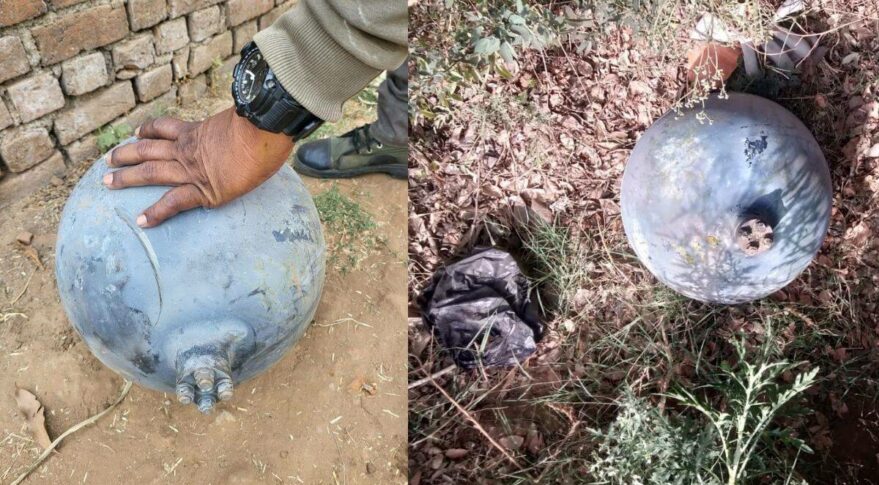 Suspected space debris that fell into rural western India May 12 are seen in this video still captured from YouTube.
Suspected space debris that fell into rural western India May 12 are seen in this video still captured from YouTube.SEOUL, South Korea — Indian authorities are examining several pieces of suspected space debris that fell into rural western India on May 12, with the timing of the incident suggesting they could be parts of a Chinese rocket that reentered the atmosphere that day.
Local media reported that the objects crashed with “loud thuds that shook the ground” in Gujarat. There were no casualties or property damage, according to The Indian Express. The crashed objects were all discovered within a 15-kilometer radius, and among them was a black metal ball weighing around five kilograms, the newspaper said.
https://spacenews.com/india-hit-by-more-suspected-space-debris/